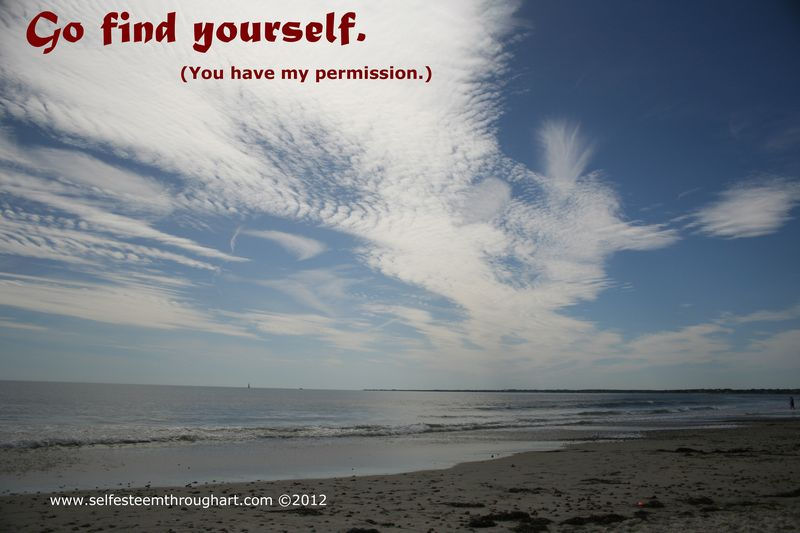I sent out a Self Esteem Through Art newsletter the other day in which the main topic was “cocooning” — the desire to just hunker down and listen to your soul. There are definitely times in my life where I want (and need) to just shut out the outside world and dive into some solitary introspection. When I have those times, I give myself that space (almost regardless of what else is going on) because I know my heart and soul are trying to tell me something. If I don’t pay attention to the silence and the signals, my head tends to get in the way – and if my head gets too involved, that often produces a less than ideal outcome.
The term “negative space” is a term that artists and designers use a lot. It refers to composition. Typically in art or in ads, there is a main subject and then there is negative space (or white space). Some would argue that the negative space is not important and you should focus solely on the main subject, but I disagree. I think the negative space lends perspective and helps you frame and interpret the main subject. If you think of Google’s homepage, that is a vast use of negative space. Their sole purpose is to guide you to their search engine. Google would be a lot different if it were designed like an amazon.com, would it not?
To illustrate my point, here is an image I recently took of the ocean. There is quite a lot of negative space in this image:
 My goal in this image was to capture the vastness of the sea and sky and the way the blues meet on the horizon. I wanted to convey not only a sense of calm and tranquility, but also a sense of wonder. Had I zoomed in on the boat or on a wave, that would have completely changed the composition of this picture. What did you think of when you saw this image? Would your thoughts have been affected by a change in composition and reduction of negative space?
My goal in this image was to capture the vastness of the sea and sky and the way the blues meet on the horizon. I wanted to convey not only a sense of calm and tranquility, but also a sense of wonder. Had I zoomed in on the boat or on a wave, that would have completely changed the composition of this picture. What did you think of when you saw this image? Would your thoughts have been affected by a change in composition and reduction of negative space?
Look at the following two photos. One uses a lot of negative space and the other is more tightly composed. Same day. Same place. Totally different feeling. In one, you are focused on the brick, on the darkness inside the ledges, and you are subtly guided through the image with the use of negative space. The texture is predominant and the people are almost your secondary focus. In the other one, you notice the people first – their expressions, their closeness, the graduation in size – and the brick becomes secondary. Negative space helps us see and helps us formulate thoughts, opinions, and conclusions.
Negative space crops up in life, too. It can be thought of as the place your heart goes when it has time to wander. It is where you have the opportunity to step back from life’s canvas a bit and put life’s demands on the back burner. It is that place that might seem kind of scary because it is where our deepest thoughts, our dusty dreams, and the feelings we tend to avoid seem to reside. As people, not artists, we tend to use negative space as a place to refocus and reevaluate.
While myriad things are clamoring for your attention – the dirty diapers, dishes, and laundry, the sports practices, bills, and orthodontist appointments, obligatory appointments, keeping those marital homefires burning, and Law and Order – you might consider negative space as less important. Inferior even. You probably push it away, ignore its attempts to get your attention, and convince yourself that it is not only unnecessary, but unreasonable to seek that space for yourself. Like ants marching.
I beg to differ. Your negative space holds critical information about who you are and what you want. It is the gateway to your passions and your purpose. Paying attention to that space in between the obligations and the chaos can dramatically shift how we perceive our every day lives. It can generate happiness and positive energy if nurtured.
I would be willing to bet that many of my readers either are currently ignoring their negative space (or have at one time) while plodding along with all of their shoulds, can’ts, and couldn’t possibly’s. A couple of examples:
- The woman who feels as though she “should” continue to climb that corporate ladder and she “couldn’t possibly” take time out to join that book club, despite having a voracious appetite for reading and socialization.
- The person, victimized by a dream-stealer and told they can’t draw, feels they couldn’t possibly consider embarrassing themselves by taking an art class.
- The parent, so focused on child-rearing, that he/she has put all of his/her dreams on the back-burner for the next 18 years (despite the gnawing sensation that a very valuable identity is being lost).
- The teen, pressured into attending his parent’s college and pursuing a major that holds no interest, because it’s what his parents want him to do and he desperately craves their approval.
While you are schlepping through your weekend, give some attention to your own negative space. Get curious about what beliefs and values are lurking in the shadows. Give yourself permission to at least contemplate a redefinition and a reassessment of your allocation of time.
From personal experience, I can pretty much guarantee that ignoring your negative space helps to cultivate feelings of tension, dissatisfaction, and resentment. Paying even a little bit of attention can cultivate feelings of satisfaction, fulfillment, and power.
Please remember: telling yourself that you don’t matter is a lie. Telling yourself that there isn’t enough time is a lie. Telling yourself “it can wait” is a lie. Honor your whole self and love yourself first — there is no shame in that!
You have my permission…now you just need to give yourself permission!
Let me know how it goes.
Much love,
Jenn




